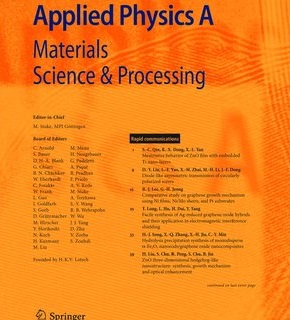A detailed analysis of linear/nonlinear optical properties of boro-tellurite glasses reinforced with ZrO2 for optoelectronics applications
Abstract
Samples of boro-tellurite glasses reinforced with ZrO2 with chemical formula (51-X)B2O3/XZrO2/10Li2O/20TeO2/19CaO: X = 0 (Zr-0), 1 (Zr-1), 2 (Zr-2), 3 (Zr-3), and 5 (Zr-5) mol% were prepared by the melt-quenching technique. A detailed analysis for linear and nonlinear optical properties was presented. In UV–Vis range, the absorption peak of Zr-X samples shifted towards longer wavelengths. The direct optical gap energy \(\left( {E_{g}^{direct} } \right)\) varied from 3.708 ± 0.001 eV to 3.523 ± 0.001 eV, while the indirect optical gap energy \(\left( {E_{g}^{indirect} } \right)\) varied from 3.395 ± 0.001 eV to 3.176 ± 0.001 eV. Urbach energy (\(E_{u}\)) changed from 0.502 ± 0.001 eV to 0.585 ± 0.001 eV. The linear dielectric susceptibility \(\left( {\chi^{\left( 1 \right)} } \right)\) increased from 0.341 to 0.361. The linear refractive index (n) enhanced from 2.298 ± 0.001 to 2.351 ± 0.001. Non-linear susceptibility (\(\chi^{\left( 3 \right)}\)) was changed from 2.406 × 10–15 esu to 2.049 × 10–15 esu. The non-linear refractive index (\(n_{2}\)) for Zr-X glasses was decreased from 3.944 × 10–14 esu to 3.284 × 10–14 esu. Both optical (σoptical) and electrical (σelectric) conductivity were increased as ZrO2 content increased. The observed optical changes are useful for solar cell and optoelectronics application.

 求助内容:
求助内容: 应助结果提醒方式:
应助结果提醒方式:


